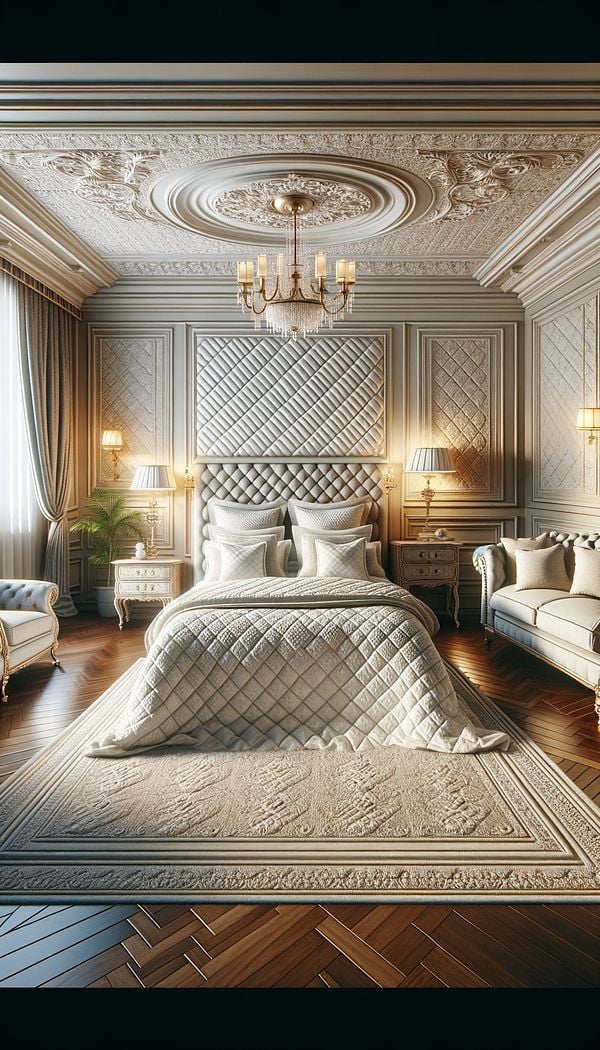What is Matelassé?
Matelassé is a weaving or stitching technique that gives fabric the appearance of padded quilting.
Description
Matelassé is a unique fabric technique that originated in France, mimicking the style of hand-stitched Marseilles type quilts made in Provence. The term itself means "padded" or "cushioned" in French, reflecting its plush, luxurious feel. This effect is achieved through a complex weaving or stitching process that creates a raised pattern on the fabric, giving it depth and texture that resembles quilting. Unlike actual quilting where two layers of fabric are stitched together with a layer of padding in between, matelassé is a single-layer fabric that ingeniously simulates this three-dimensional look. The detailed designs and elaborate patterns often found in matelassé textiles contribute to their decorative appeal, enriching the visual and tactile experience of interior spaces.
Matelassé can be made from various fibers including cotton, wool, or synthetic blends, making it versatile for different applications in interior design. It's predominantly used in high-end home textiles such as bedspreads, coverlets, duvet covers, and decorative pillows. This technique can also be found in upholstery and drapery, adding a touch of elegance and sophistication to furniture and windows. Due to its intricate weaving, matelassé adds visual interest and texture to any room, fitting well with various design styles, from traditional to contemporary. Furthermore, its raised pattern provides a cozy, inviting feel, enhancing the comfort and aesthetic appeal of living spaces.
Usage
Matelassé is often selected for its rich texture and luxurious appearance, making it a popular choice for bedding and home textiles in upscale hotels and residences. Its use in upholstery can add depth and character to otherwise simple furniture pieces. In modern home decor, matelassé throw pillows or coverlets can serve as statement pieces, adding a refined touch to living rooms and bedrooms. Additionally, when used in window treatments, matelassé fabric can enhance privacy and insulation while also elevating the room's overall design.
FAQs
-
Is matelassé fabric heavy?
Matelassé can be heavier than standard fabrics due to its textured weave, but the actual weight can vary based on the fibers used. Cotton matelassé tends to be lighter and more suitable for warmer climates, whereas wool or synthetic blends might be thicker and warmer.
-
Can matelassé be washed at home?
Yes, many matelassé fabrics are machine washable, especially those made from cotton. However, it's essential to follow the manufacturer's care instructions closely to avoid damaging the fabric's textured appearance.
-
How do I choose the right matelassé for my project?
Consider the use of the fabric, whether for bedding, upholstery, or window treatments. Think about the desired texture and weight, as well as the overall design style of your space. Opt for colors and patterns that complement your decor, and ensure the matelassé fabric aligns with the room's functional and aesthetic needs.
Practical Application
When incorporating matelassé into your interior design, consider using it as an accent to add texture and depth to your space. For bedding, look for high-quality cotton matelassé for comfort and ease of care. In upholstery, matelassé can elevate the look of simple furniture pieces, making them standout features in a room. Finally, for window treatments, select a matelassé fabric that balances visual appeal with functionality, ensuring it enhances privacy and insulation while adding a touch of elegance.
-
Decorating Principles & Elements330 articles
-
Materials & Textiles360 articles
-
Textiles & Upholstery252 articles
-
GreigeGreige is a color that blends gray and beige tones.
-
Picture RailA molding on a wall from which pictures are hung.
-
Fleur De LisA stylized lily or iris, used as a decorative design or symbol.
-
PatinaPatina is a thin layer that forms on the surface of copper, bronze, and similar metals (due to oxidation), or on wooden and leather surfaces through aging, wear, and exposure.
-
VaseA vase is a container, traditionally made of glass or ceramic, used primarily for holding cut flowers or as a decorative piece.
